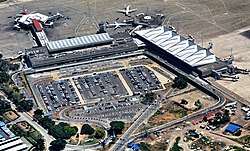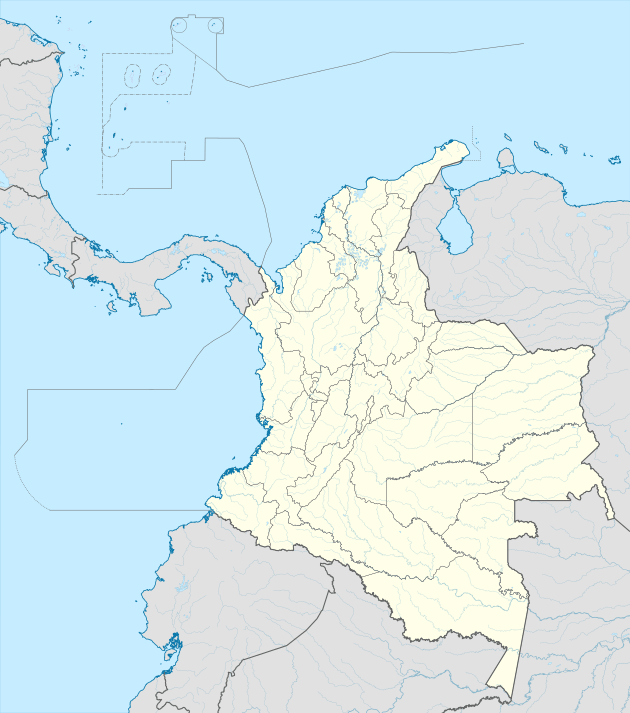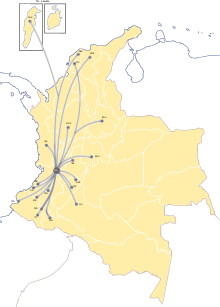Alfonso Bonilla Aragón International Airport
Alfonso Bonilla Aragón International Airport (IATA: CLO, ICAO: SKCL) formerly known as Palmaseca International Airport is located between Palmira and Cali, the capital of Valle del Cauca Department, Colombia. It is Colombia's 4th busiest airport in passenger volume, with 5,600,000 people using the airport in 2016. It is the third largest airport in Colombia in terms of area and construction. The airport often serves as the alternate airport for Bogotá - El Dorado Int'l Airport and other Colombian airports.
Alfonso Bonilla Aragón International Airport Palmaseca International Airport | |||||||||||
|---|---|---|---|---|---|---|---|---|---|---|---|
 | |||||||||||
| Summary | |||||||||||
| Airport type | Public | ||||||||||
| Owner | Aeronáutica Civil | ||||||||||
| Operator | Aerocali | ||||||||||
| Serves | Santiago de Cali, Palmira, Colombia | ||||||||||
| Elevation AMSL | 3,162 ft / 964 m | ||||||||||
| Coordinates | 3°32′30″N 76°22′55″W | ||||||||||
| Website | www | ||||||||||
| Map | |||||||||||
 CLO Location of airport in Colombia | |||||||||||
| Runways | |||||||||||
| |||||||||||
| Statistics (2019) | |||||||||||
| |||||||||||
Alfonso Bonilla Airport lies in the center of the wide and fertile Cauca River valley, which runs north - south between the Western and Central Colombian Andes ranges. It is approximately 5 hours flight from Santiago de Chile, 50 minutes from Quito, Ecuador, and about 3 hours 18 minutes from Miami airport.
The airport has one 3.000m long runway, equipped with the following navigation aids: primary radar, secondary radar, ILS, ALS, PAPI, RVR, runway centerline lights, threshold lights, and taxiway lights. The airport has SEI IX[3] protection.
The Cali non-directional beacon (Ident: AS) is located 0.59 nautical miles (1.09 km) off the Runway 02 approach threshold. The Cali VOR-DME (Ident: CLO) is located 7.78 nautical miles (14.41 km) off the Runway 02 threshold.[4][5]
Alfonso Bonilla airport is notable for being one of the very few secondary airports in Latin America that operates 24 hours a day. This is made possible not only by the year-round stable, consistent meteorological conditions but also because it is 14 kilometres (8.7 mi) away from both Cali and Palmira. That distance frees it from any environmental/noise restrictions, allowing aircraft to take off and land at any time of day. Alfonso Bonilla Aragón International Airport has non-stop flights to the United States, Spain, Ecuador, Panama and Peru.
History
On April 21, 1921 Ferruccio Guicciardi flew his Italian-made Macchi-Hanriot HD-1, (named "Telegraph I") from Guayaquil, Ecuador, to Cali, with stops in Quito and Pasto, Colombia. This was the first aircraft ever to land in Cali. He claimed the $9,500 peso prize offered by the Department of Valle and the Cali City Council to the first pilot who landed in the city. This event marked the birth of aviation activity in the capital of Valle del Cauca.
SCADTA
Following the war with Peru in 1932, President Enrique Olaya Herrera sought the help of SCADTA engineers and pilots to find a suitable site for an airport capable of providing air support to military operations. After evaluating several alternatives, the German pilot Herbert Boy chose an area called "El Guabito" because of its location, proximity to the city and an extension of Juanchito Antioquia Avenue. After leveling the land with bulldozers a fledgling Air Force Base and Air National Guard station were built and operations began on September 21, 1933. Eventually, the number of airlines operating from the airport grew to include TACA de Colombia and VIARCO SAETA along with the already established SCADTA Panagra.
However, Panagra began looking for a suitable place for an airport in order to link South America with Panama through Cali, as well as its domestic flights operated by Avianca. To this end they acquired land in the municipality of Candelaria, 18 miles from the center of Cali. On April 17, 1947 the modern facilities at "Calipuerto" were inaugurated. The airport passed to the Colombian state in the 1950s and was subsequently taken over by the Civil Aeronautics Department in 1968.
In 1946, the company VIARCO valle, under the management of Ricardo A. Deeb, implemented an expansion policy including the construction of its own airport in Cali. The airport would be open to all airlines in the country except Avianca. In November 1946, the Aviation Authority requested an inspection of the new "El Limonnar" airport, located in the Pasoancho area of the city. In early 1947, the works were completed at the airport, which was put in service equipped with the most modern facilities and equipment at that time. LANSA and other smaller companies also moved operations to this airport from the military airport at El Guabito, later renamed the Marco Fidel Suarez AFB. El Limonar was closed in 1954 following a merger between LANSA and Avianca and the subsequent transfer of operations to Calipuerto. The city of Cali, like Bogota, at that time had three active airports in operation. When the new Palmaseca Airport opened the old Calipuerto buildings and runways were adapted and expanded to house Cavasa, an agricultural and food products distribution centre.
Palmaseca International Airport
The history of the new airport is directly linked to the 1971 Pan American Games, which were held in Cali. The infrastructure required to host an event of this magnitude made both the local and national government agencies broaden their horizons and commit to building the long-awaited and much needed facility. The Civil Aeronautics Agency had already purchased a large plot of land from Hacienda Palmaseca in the neighbouring town of Palmira. The project was beset by operational and financial difficulties, and the central government had to inject a further US$35 million in order to complete the physical construction and meet international aviation safety standards. Furthermore, new roads linking the airport to the industrial city of Yumbo and the main Cali - Palmira highway were also built as part of the project.
Palmaseca International Airport was inaugurated on July 24, 1971 during the government of President Misael Pastrana Borrero. It had 3000m long runway, taxiways, parking apron, and a main terminal building for domestic and international flights. The terminal was equipped with airline service counters, restaurants, shops, a small hotel and even a nondenominational prayer chapel for nervous passengers. Although some critics initially claimed it was unnecessarily large and expensive for the city's needs at the time, air operations and passenger numbers quickly grew, justifying the size and cost of the project. The electronic, communications and safety equipment at the airport was recognized when it was designated as the alternate for Bogotá's El Dorado Int'l. Airport.
In June 1989 local authorities renamed the airport in honour of "Alfonso Bonilla Aragón", a local civic leader and journalist who played a prominent role in the approval and construction of the airport. This decision proved highly unpopular with the people of Cali, and there were serious efforts made to reverse the decision. Even the Business Guilds and the Cali Chamber of Commerce formally requested that the government intercede and force the Civil Aeronautics Agency to change the name back to "Palmaseca".[6]
Reform and Privatisation
At the beginning of 1982, Álvaro Uribe Vélez, Director of Civil Aeronautics, made the decision to decentralize the management of two important international airports: Palmaseca in Cali and Olaya Herrera in Medellín. Palmaseca would be administered by a mixed economy company, proposed by the Permanent Business Committee of Valle del Cauca and the Cali Chamber of Commerce. The entity that would have to abide by the rules of public establishments would be 90% economically backed by state capital and 10% by private capital. The shareholders included Empresas Públicas de Cali, Palmira, Cortuvalle, C.V.C and Corporación Financiera del Transporte. This decentralization was never carried out and only years later the privatization process began
In the mid-1980s, part of the international terminal satellite collapsed, causing many criticisms of the design and construction firms of the building. In 1986 Civil Aeronautics had to assume the reconstruction of the international terminal satellite, together with the reinforcement in the rest of the structure.
The md 1980's saw the construction of the cargo terminal, the general aviation area and a new airport fire station. In mid-1989 the main runway was repaved, which had deteriorated along 700 meters of the 3000 total meters in length. The general aviation area was also built, which unfortunately soon became a clandestine center for drug trafficking operations.
For this reason the Aeroclub del Pacifico decided to acquire a large plot of land near the Free Trade Zone, adjacent to the header 1-9 to build its new facilities with direct access to the taxiway.
Years later the National Museum of Transport was built in that area, which is well worth visiting.
Structure and capacity
- Loading facilities feature a 747 freighter dock, bonded warehouse, in-transit area, free trade zone, cargo loading and unloading vehicles and equipment, public health officials, secure storage for valuables, express and messenger center.
- Avianca has an Executive Lounge on the top floor of the Domestic Satellite Terminal, offering free Wi-Fi, cable TV, a wet bar and snacks counter, free newspapers and charging ports for mobile devices.
Services
There are car hire desks, ATMs, currency exchange services, public phones, and free Wi-Fi.
- Eating: Restaurants, cafés, fast food outlets, and two bars.
- Shopping: Souvenir items, bookshops, duty-free perfume, liquor and emeralds, pharmacy, sporting apparel and equipment, electronic devices
- Baggage: Airlines offer baggage claim offices for passengers who have lost their luggage.
- Parking: There is a large parking area in front of the terminal.
- Hotels: There is a Hotel named GHL comfort at 3rd level of airport where one can stay.
Airlines and destinations

Passenger
The following airlines operate regular scheduled and charter flights at the airport. Due to the COVID-19 pandemic, all regular scheduled flights are currently suspended.
| Airlines | Destinations |
|---|---|
| Albatros Airlines | Porlamar |
| American Airlines | Miami |
| Avianca | Bogotá, Cartagena, Madrid, Medellín–JMC, Miami, New York–JFK1 Seasonal: San Andrés Island |
| Avianca Ecuador | Guayaquil |
| Avianca Express | Pasto, Tumaco |
| Avior Airlines | Caracas |
| Copa Airlines Colombia | Panama City–Tocumen |
| EasyFly | Bucaramanga, Ibagué, Medellín–JMC, Neiva, Pasto, Puerto Asis, Quibdó, Tumaco, Villavicencio |
| Gran Colombia de Aviación | Barranquilla, Cartagena |
| JetSmart | Santiago de Chile |
| LATAM Colombia | Bogotá, Cartagena, San Andrés Island |
| LATAM Perú | Lima |
| Plus Ultra Líneas Aéreas | Madrid |
| Satena | Florencia, Guapi, Medellín–Olaya Herrera, Puerto Asis, Quibdó, Tumaco, Villagarzon |
| Spirit Airlines | Fort Lauderdale |
| TAC | Timbiquí |
| Viva Air Colombia | Barranquilla, Cartagena, Medellín–JMC, San Andrés Island |
| Wingo | Cartagena, Panama City–Balboa, San Andrés Island |
Cargo
| Airlines | Destinations |
|---|---|
| Avianca Cargo | Medellín-JMC, Miami |
| LATAM Cargo Colombia | Miami[7] |
Accidents and incidents
- On 21 January 1974, a Vickers Viscount of Aeropesca Colombia was hijacked and diverted to Cali.[8]
- On 6 June 1992, Copa Airlines Flight 201 from Panama City to Bonilla Aragón Airport crashed in the Darién Gap due to spatial disorientation caused by instrument malfunction.
- On 20 December 1995, American Airlines Flight 965 from Miami to Bonilla Aragón Airport crashed into a mountain near Cali due to pilot error resulting from misinterpretation of waypoints meant to guide the plane into Bonilla. It remains the deadliest air disaster in Colombia.
References
- Airport information for CLO at Great Circle Mapper.
- Google Maps - Cali
- Security measures
- Cali NDB
- Cali VOR
- Escobar, Jaime. Aviacol.net
- https://m.benzinga.com/article/15306881
- "Accident description". Aviation Safety Network. Retrieved 8 October 2009.
External links
![]()
- Cali Airport at OpenStreetMap
- Cali Airport at OurAirports
- Aeronautical chart and airport information for Cali Airport at SkyVector
- Accident history for CLO at Aviation Safety Network
- Airport information for SKCL at World Aero Data. Data current as of October 2006.
- Current weather for SKCL at NOAA/NWS